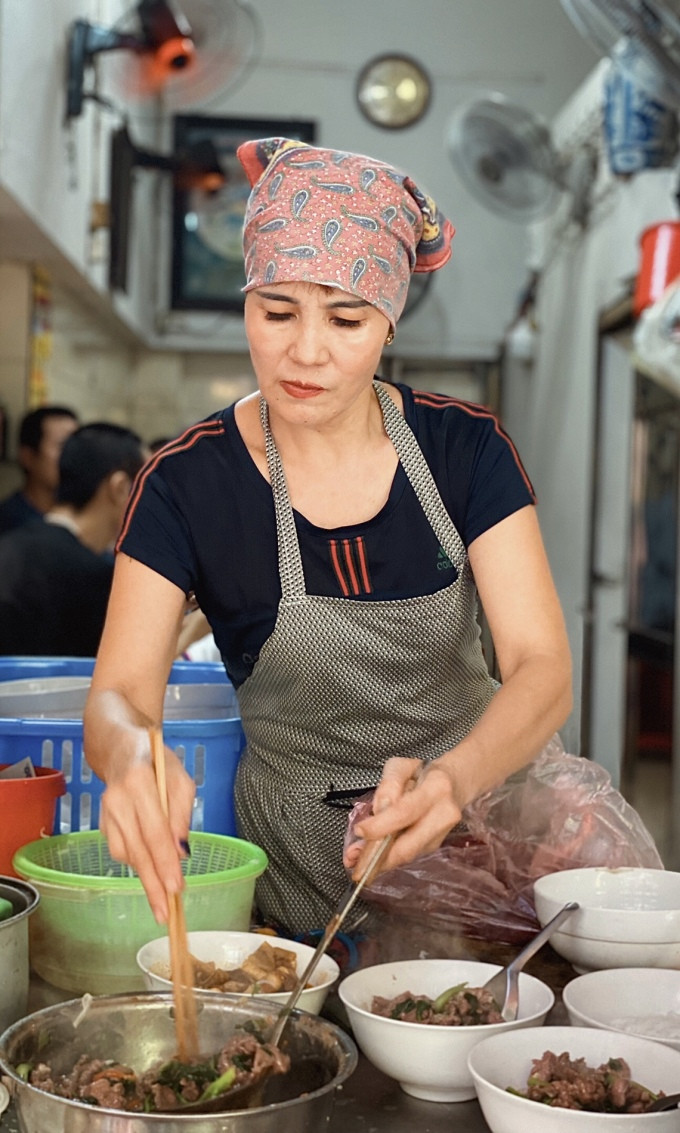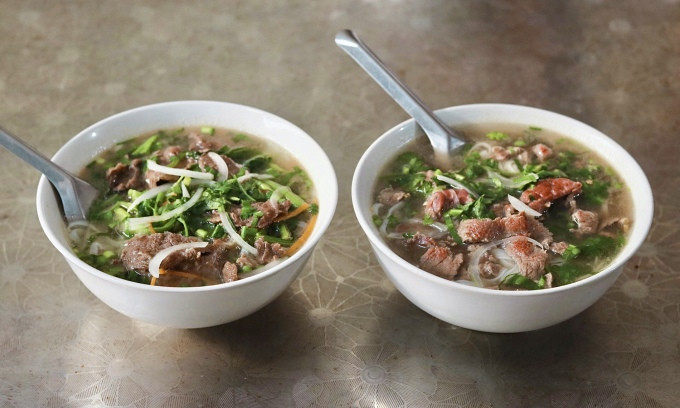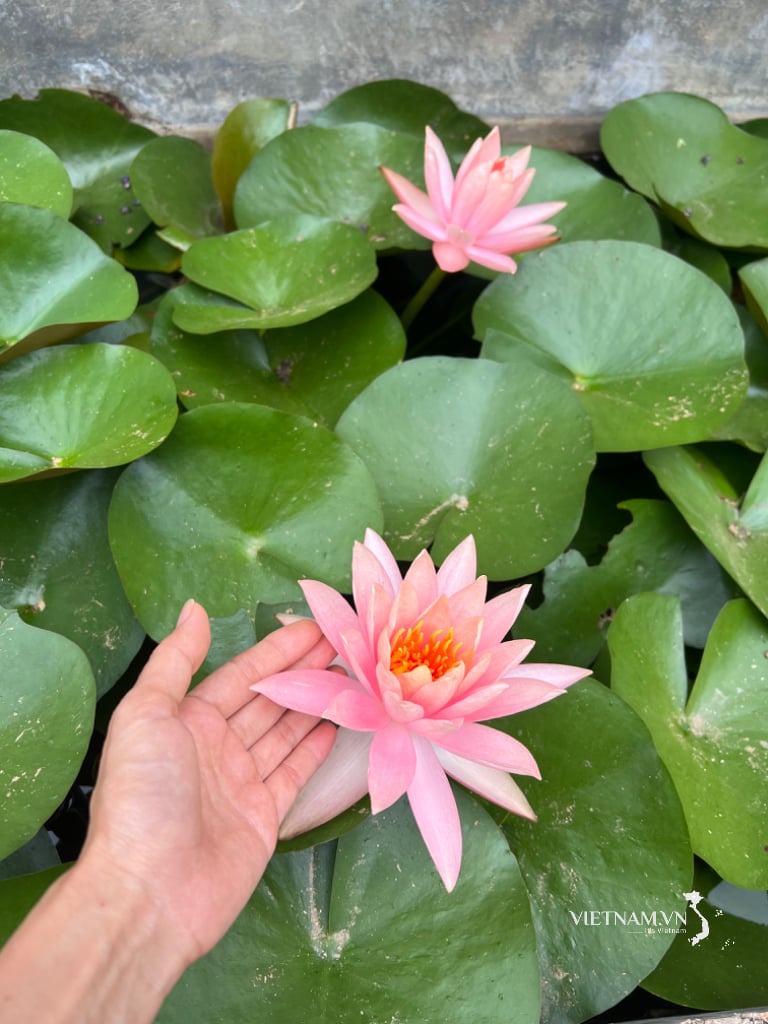Nam Dinh pho has a strong fish sauce flavor, commonly pan-fried or rare, while Hanoi pho has a clear and light broth, with main dishes being rare, well-done, and rare well-done.
Pho Hanoi and Pho Nam Dinh were recognized as National Intangible Cultural Heritage on August 9. Despite much debate, both localities are considered the "birthplace" of pho. However, pho in each place has its own differences.

Regarding the origin, in the book "One Hundred Years of Vietnamese Pho" published in 2022, scientist Trinh Quang Dung, Vietnam Academy of Science and Technology, said that there are two opinions about the origin of pho: Hanoi or Nam Dinh. Accordingly, in the early 20th century, the "pho troop" of Nam Dinh pho traveled to Hanoi to practice. Also during this time, the original pho lineage appeared in Di Trach, Ha Dong province (now Hanoi).
Another unofficial theory, mentioned in the Heritage Profile of Nam Dinh Province, suggests that a chef in Nam Dinh city invented pho because this was once the largest colonial textile center in Vietnam, home to French owners and Vietnamese workers. The chef came up with a soup that would please both groups. He used two main ingredients: pho noodles (of Vietnamese origin) and beef (of French origin) and added some spices to create the pho as it is today.
Nguyen Thanh Dung, University of Social Sciences and Humanities, on Nam Dinh pho in Hanoi in 2001, mentioned by the Hanoi Department of Culture and Sports in the document recognizing "National Intangible Cultural Heritage", also has the same opinion. Accordingly, based on the story of the owners of some pho shops in Hanoi who are from Nam Dinh, it is possible that people from Van Cu village, Tay Lac (Nam Dinh) went to Hanoi to work for Chinese shops and learn the trade, then stayed in Hanoi to open pho shops, contributing to the formation of the "Nam Dinh Pho" brand in Hanoi. Hanoi has since become the cradle for pho to develop because the market is more abundant.
In terms of preparation, the broth is the most important ingredient of each bowl of pho, and is also a feature to evaluate the quality of the dish. The broth shows sophistication thanks to the combination of herbs and spices to create a unique flavor. The difference between Hanoi and Nam Dinh pho also lies here.
With Nam Dinh pho, the broth cannot lack the fish sauce produced in the local sea. The recipe and process of making the broth is both a family secret passed down through many generations in Nam Dinh families such as Pho Cu Tang, Pho Co, and also the creativity and mark of the next generation. The broth is simmered from marrow bones, and oxtail can be added to create a rich flavor. When simmering the bones, the broth is used a second time to avoid the bad smell of the beef bones.
With Hanoi pho, the long-standing pho shops here only cook the broth from beef bones combined with ginger, adding roasted onions, cinnamon, star anise, cardamom and other ingredients. The ratio and timing of adding the ingredients to the broth is the secret of each shop. During the simmering process, the foam must be skimmed off, after 24 hours, the broth must be taken out and the broth is drained. The broth is seasoned with salt and spices, very few places use fish sauce like Nam Dinh.

Nam Dinh Pho has both rare and well-done dishes, but pan-fried is popular and loved by Nam Dinh people. The beef is stir-fried in a hot pan with crushed garlic, greens, tomatoes, onions, carrots, then seasoned with spices, pepper, and a little pho broth to soften the meat. After blanching the noodles, add the stir-fried beef on top and pour in the broth and enjoy.
Popular Hanoi pho dishes are rare, well done, and rare well done. The meat is usually tenderloin, brisket, or beef tenderloin. The meat is sliced thinly along the grain.
The difference lies in the variation: Hanoians add chicken pho. Chicken pho broth is simmered from bones, heads and feet of chickens or pork bones combined with ginger, boiled, skimmed off the foam and simmered until the bones release their sweet broth. Good chicken is usually naturally raised chicken weighing no more than two kilograms. The chicken skin is yellow, the meat is dark pink without fibers and has no fat under the skin.
In terms of enjoyment, the similarity between Hanoi and Nam Dinh pho is that good pho restaurants often have shabby tables and chairs. Pho tables are a bit lower than normal so that the broth does not splash on the clothes when diners bend down. There was a time when air-conditioned pho restaurants from the South appeared in Hanoi, but they did not develop and were considered unsuitable for the culture and eating habits.

Hanoians eat pho without squeezing lemon or adding chili sauce, only using garlic vinegar and fresh chili because the sourness of lemon is stronger than that of vinegar, so lemon enhances the flavor of chicken pho broth, but ruins the flavor of beef pho. However, many pho restaurants now serve lemon, chili, garlic vinegar and fried breadsticks. Hanoi pho is often eaten with bamboo chopsticks and spoons.
Pho restaurants in Hanoi usually specialize in one type of pho, beef or chicken. The reason why you cannot serve both beef and chicken pho is because the flavors will mix, and the broth cannot be used together. Pho is served in a bowl, without any other dishes, except for fried breadsticks.
Traditionally, Nam Dinh and Hanoi pho noodles have large, hand-cut noodles, with moderate thinness. The noodles are soft and smooth but not mushy, and absorb the sweet aroma of the broth. However, most pho noodles are now machine-cut, so the noodles are smaller.
According to 2024 statistics of the Department of Culture, Sports and Tourism of Nam Dinh, the province has nearly 500 pho shops, of which Nam Dinh city and Nam Truc district are home to many long-standing shops, many of which have been around for two generations, such as Pho Cu Tang, Hai Pho, Pho Truong, Pho Ba Thu, Pho Tao, Pho Co. In Hanoi, statistics by the end of 2023 of the Department of Culture, Sports and Tourism show that there are nearly 700 pho shops in the capital, mainly concentrated in Ba Dinh (21 shops), Hoan Kiem (32), Cau Giay (29), Dong Da (9), Hai Ba Trung (30), Thanh Xuan (56), Long Bien (93) districts. Traditional pho brands include Pho Chieu, Pho Tinh, Pho Tu Lun, Pho Suong, Pho Vui, Pho Nho, Pho Thin (Bo Ho), Pho Thin Lo Duc.
Source





![[Photo] Prime Minister Pham Minh Chinh receives the Chairman of the Japan-Vietnam Friendship Association in the Kansai region](https://vphoto.vietnam.vn/thumb/1200x675/vietnam/resource/IMAGE/2025/11/03/1762176259003_ndo_br_dsc-9224-jpg.webp)
![[Photo] General Secretary To Lam receives Singaporean Ambassador Jaya Ratnam](https://vphoto.vietnam.vn/thumb/1200x675/vietnam/resource/IMAGE/2025/11/03/1762171461424_a1-bnd-5309-9100-jpg.webp)
![[Photo] Lam Dong: Close-up of illegal lake with broken wall](https://vphoto.vietnam.vn/thumb/1200x675/vietnam/resource/IMAGE/2025/11/03/1762166057849_a5018a8dcbd5478b1ec4-jpg.webp)







































































































Comment (0)